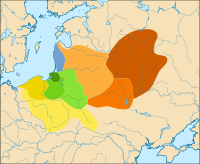You can help expand this article with text translated from the corresponding article in Polish. (November 2016) Click for important translation instructions.
|
| This article needs additional citations for verification. Please help improve this article by adding citations to reliable sources. Unsourced material may be challenged and removed. Find sources: "Milograd culture" – news · newspapers · books · scholar · JSTOR (July 2016) (Learn how and when to remove this message) |

The Milograd culture (also spelled Milahrad or Mylohrad, also known as Pidhirtsi culture on Ukrainian territory) is an archaeological culture, lasting from about the 7th century BC to the 1st century AD. Geographically, it corresponds to present day southern Belarus and northern Ukraine, in the area of the confluence of the Dnieper and the Pripyat, north of Kyiv. Their ethnic origin is uncertain, but likely to be either Baltic or Early Slavic.
The town of Milahrad (Belarusian: Мілаград), after which the culture is named, is located in the Gomel Region of Belarus.
See also

- Middle Dnieper culture
- Pomeranian culture
- Zarubintsy culture
- Przeworsk culture (Middle and Upper Vistula with the right bank of the Oder)
- Chernoles culture (Pripyat basin, Middle Dnieper and part of Upper Dnieper)
References
- Hypothesis of V. Sedov about the Slavic original homeland; "[Projekat Rastko] Valentin V. Sedov: Slavs in Antiquity". Archived from the original on 11 January 2014. Retrieved 11 January 2014.
External links
- Scythians/Sacae by Jona Lendering
This article about Belarusian history is a stub. You can help Misplaced Pages by expanding it. |
This Ukrainian history–related article is a stub. You can help Misplaced Pages by expanding it. |